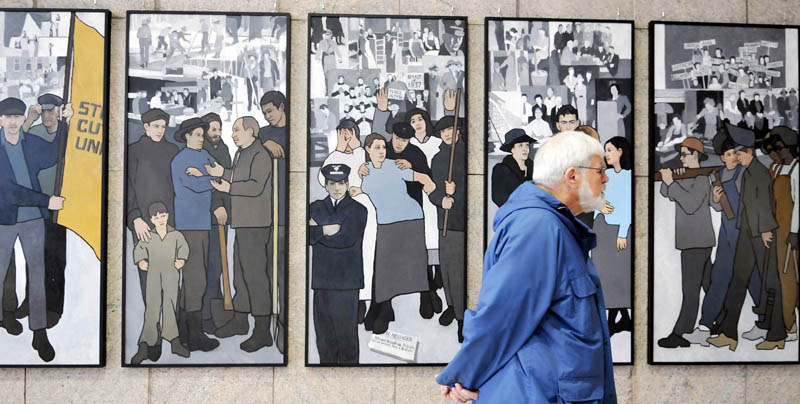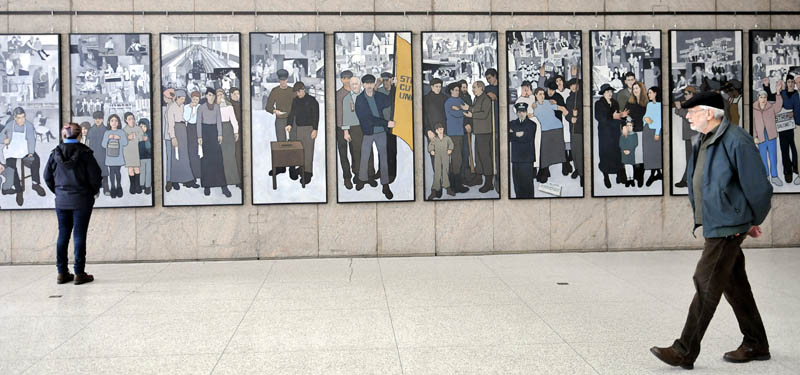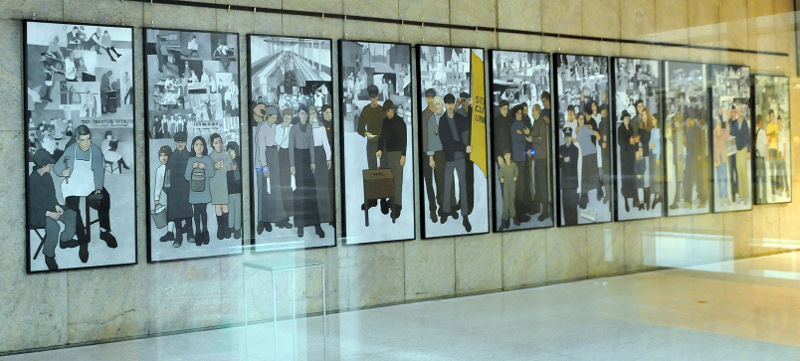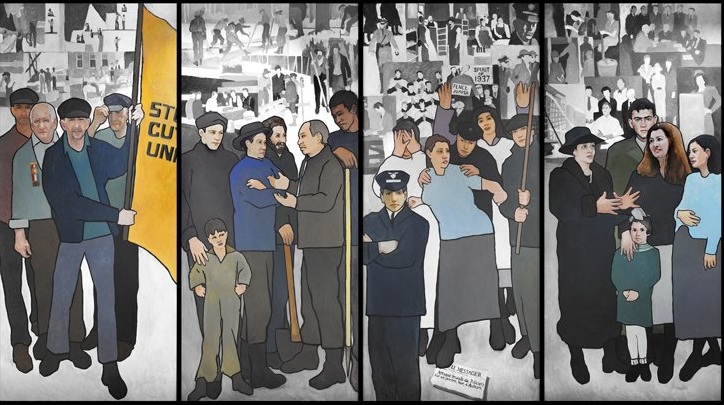The controversial labor mural that once hung in the lobby of the Maine Department of Labor in Augusta — and became the subject of a lawsuit when Gov. Paul LePage ordered it removed — has found a new home.
The mural will reside for at least the next three years in the Cultural Building atrium that serves as the entryway to the Maine State Museum in Augusta.
Officials from the Department of Labor and the Maine State Museum made the announcement in a joint news release Sunday night.
LePage has no objections to the 11-panel, 7-foot-tall mural being moved to the museum, his spokeswoman said.
The mural, which was installed in the museum entryway over the weekend, will be unveiled in a presentation at 8:30 a.m. Monday, a day when the museum is usually closed, and open for viewing from 9 a.m. to noon.
Although the mural is still owned by the Department of Labor, the museum and state have agreed to a three-year, renewable display deal.
“It’s in a great space. It will be well cared for and it will have security keeping an eye on it. The number of people who go to the museum will be far greater than our labor offices,” Julie D. Rabinowitz, spokeswoman for the Department of Labor, said Sunday night.
The mural — depicting World War II’s “Rosie the Riveter,” a 1937 shoe strike in Maine, New Deal-era U.S. Labor Secretary Frances Perkins and other events in Maine labor history — was commissioned by Democratic Gov. John Baldacci. The $60,000 art project was funded with a federal grant, Rabinowitz said.
The long battle over the now-famous mural began in 2011, soon after LePage, a Republican, was inaugurated. The governor criticized the mural as a one-sided view sympathetic to unions. He compared it at one point to Communist propaganda in North Korea.
LePage’s administration quietly took the mural down over a weekend and stored it at an undisclosed location. Artists, labor advocates and others criticized the decision, saying he had no authority to arbitrarily remove the artwork.
Five Mainers, including three artists, later filed a lawsuit claiming the removal violated the First Amendment right to free speech of the mural’s artist, Judy Taylor of Blue Hill.
The case made its way to federal court in Maine, where U.S. District Judge John Woodcock Jr. sided with LePage. The case was then sent to the U.S. 1st Circuit Court of Appeals in Boston, which affirmed the Maine federal court’s view.
The Appeals Court ruled that the mural represented government speech, a special category of statement that was the government’s to make or withdraw at its discretion.
Jeffrey Neil Young, the attorney who brought the lawsuit against the state, said the museum is an appropriate location for the mural.
“I’m glad that Governor LePage and I are finally on the same page,” he said. “It’s important that Mainers have the chance to see their history.”
During the dispute, no one except a few people in the governor’s administration knew where the mural was stored.
Rabinowitz, who has only been in her job for six months, had asked not to be told about the exact location. She was assured that the mural was placed in crates and stored in a secure location on Department of Labor property.
The museum inspected the mural before accepting it and said it was in good condition, she said.
“At last the labor mural will see the light of day,” said Matt Schlobohm, executive director of the Maine AFL-CIO. “The governor’s actions disrespected generations of hard-working Maine people.”
Schlobohm said he still believes LePage had no right to remove the mural and hide it from public view.
“It’s unfortunate the mural was put in hiding for two years,” he said. “Where was it hidden? … That’s the million-dollar question.”
Rabinowitz said the Department of Labor began looking for a suitable place to display the mural in December, after the federal court ruling. But it was unable to identify a department site that would work.
Then the week before Christmas, the state was approached by Bernard Fishman, the new director of the Maine State Museum.
“He said, ‘Let’s make this work,'” Rabinowitz recalled.
She said the artist, Judy Taylor, told the state she thought it would be great if the museum became the home for her artwork. Taylor could not be reached for comment Sunday.
Rabinowitz said the mural is a good fit with the state museum because it has “gained in historical significance” during the controversy of the past two years.
“At the point it was taken down, it was a piece of contemporary art hanging in a lobby” and very few people knew it existed, she said. “It has since taken on a meaning beyond what it used to have. Now it is being called the most famous piece of art in Maine.”
At least one other museum approached the state about displaying the mural, but the Maine State Museum won out.
The museum wants to make the piece a permanent part of its collection, but there are restrictions on what can be done with the mural because it was funded with federal dollars. The museum hopes to work out an agreement with federal officials.
Adrienne Bennett, LePage’s spokeswoman, said Sunday night that the governor was kept informed of the search for a new home and believes the museum is a suitable location for the mural.
“He is supportive of this. The governor has always said it needs to be in a more accessible location. Just think of all the schoolchildren who go to the museum,” Bennett said. “It’s in a place where it is going to be viewed by a lot of people on a regular basis.”
The Cultural Building atrium is a two-story hall with granite walls and a lot of natural light. The atrium also serves as the entryway to the Maine State Library and the Maine State Archives.
“We are thrilled to make the mural available, as Gov. LePage always promised, to the people of Maine now that the litigation has ended,” said Jeanne Paquette, Maine’s commissioner of labor. “Our goal has always been to find a space that can fit the 33-foot-long work and also provide security it now needs as a famous piece of art.”
Staff Writer Dennis Hoey can be contacted at 791-6365 or at:
dhoey@pressherald
Send questions/comments to the editors.









Comments are no longer available on this story